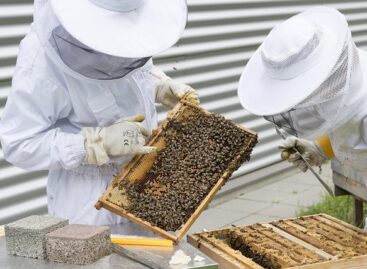Hungarian grasslands are of great value, and the government supports their preservation
The Grassland-HU LIFE integrated project plays a key role in the long-term preservation of Hungarian grasslands, emphasized Bertalan Balczó, Deputy State Secretary for Nature Conservation at the Ministry of Agriculture, at the opening event presenting nature conservation mowing on Wednesday in Kőszeg.

(Photo: AM/Orsolya Kozelka)
Hungarian grasslands, the habitats of the Pannonian biogeographic region that have remained in a natural and semi-natural state, are among the most valuable natural treasures of the Carpathian Basin, which are of outstanding importance not only for biodiversity, but also for climate protection and sustainable agriculture. Hungary therefore bears a special responsibility for the preservation of the unique grassland types of the Pannonian biogeographic region. Hungarian grasslands, from sandy wastelands to saline areas and mountain meadows, are home to an extremely rich flora and fauna, with three-quarters of protected plant species and half of protected animal species associated with these habitats. For example, the highly protected tawny owl, Hungarian anemone, Beagle, bustards and the Hungarian grasshopper mouse can be found here. The biodiversity of grasslands and its changes affect the functioning of ecosystems, the availability and quality of water, food security, human plant and animal health, and the resilience to the effects of climate change. The Hungarian national park directorates manage more than 200 thousand hectares of grasslands, on which habitat development, restoration and management work is ongoing – based on decades of professional experience, the available management tools and funding. However, in order to achieve the nature conservation goals of preserving Hungarian grasslands, work based on broad cooperation with the livestock sector and farmers is needed, going far beyond the management tasks of the directorates. The protection, restoration and sustainable management of grasslands requires the cooperation of national parks, nature conservation authorities, farmers and local communities, the Deputy State Secretary stated.
A national grassland strategy will be developed within the framework of the Grassland-HU LIFE project, which will support farmers in Natura 2000 areas and promote the conservation of protected species and habitats
The program also includes infrastructural developments, such as the creation of grazing conditions, shrub removal, and the suppression of invasive species. In addition, a national invasive species database is being created, which will provide nature conservation authorities with information on the occurrence and management options of individual invasive species. The model farm network established within the framework of the project – of which the Kőszeg Evangelical Secondary School Farm is a member – plays an important role as it provides an opportunity to widely share practical experiences and good examples of nature-friendly grassland management with stakeholders in the sector.
AM
Related news
The value of agricultural output is expected to increase by around 6 percent in 2025
🎧 Hallgasd a cikket: Lejátszás Szünet Folytatás Leállítás Nyelv: Auto…
Read more >Ministry of Agriculture: further help for the dairy sector, educational institutions can join the school milk program even during the school year
🎧 Hallgasd a cikket: Lejátszás Szünet Folytatás Leállítás Nyelv: Auto…
Read more >The payment of bee animal welfare subsidies has begun
🎧 Hallgasd a cikket: Lejátszás Szünet Folytatás Leállítás Nyelv: Auto…
Read more >Related news
Hungarian professional leadership also shaped global economic decisions at the historic B20 summit in South Africa
🎧 Hallgasd a cikket: Lejátszás Szünet Folytatás Leállítás Nyelv: Auto…
Read more >Foodora expands: it brought fast delivery to 21 new cities this year
🎧 Hallgasd a cikket: Lejátszás Szünet Folytatás Leállítás Nyelv: Auto…
Read more >One hundred thousand smiles in ten years – The 10th Christmas SmileElves campaign has ended
🎧 Hallgasd a cikket: Lejátszás Szünet Folytatás Leállítás Nyelv: Auto…
Read more >






